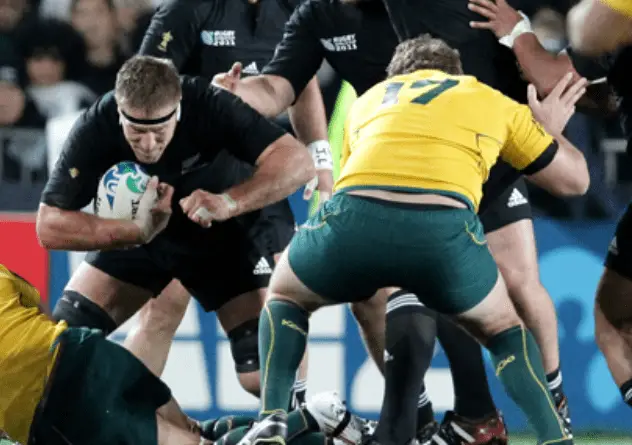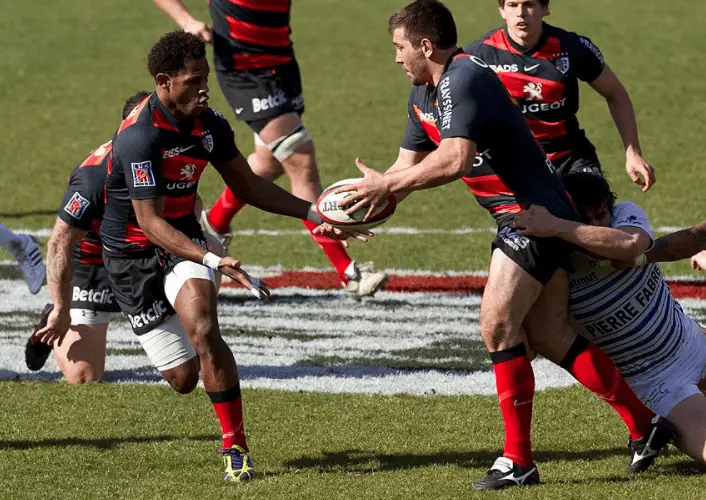Looking back on my ‘career’ in rugby there were two sorts of players. Those that actively went out seeking contact and those that avoided it at all cost. Love it or hate it, contact skills play a huge role in rugby and can make or break a players future in the game.
We are going to look at some of the most basic contact skills required in rugby to set you on the right path. When you have the ball and contact is inevitable, you essentially have options: hit and engage, hit and spin, hit and pass, and hit and go to ground. Here’s how to execute these skills correctly:
The Hit And Engage
At some point all players are going to have to take contact whether they choose to or not. Doing so with the correct technique will aid in keeping possession of the ball and in making progress whilst in the tackle.
Before: The balls should be held in two hands in order to facilitate an offload if possible or to keep it secure in the contact. On approach to the contact zone the body position should be low and stride lengths should shorten and then there should be one larger power stride into the contact.
During: Contact should be made with the points of the body i.e. the shoulder and hips. Maintain a wide stance to provide a stable base and keep driving forward with short steps. The ball needs to be transferred so that it is shielded from opponents where possible.
After: With enough momentum you may keep on driving but it is likely that at some point the maul will stop moving or go to the ground. This is when it is imperative to have the ball presented in the right position for team mates to regather and play with.
Pro tip: Get aggressive in contact without it you are going to lose momentum far more quickly. Take pride in never taking a backward step in contact. The first contact you make is essential in putin a little fear into your opponents at the beginning of the game.

There are lots of rules related to the contact area in rugby so I have put together a simplified guide to the rules of rugby here.
The Hit And Spin
Quite a rare sight in the game these days but a real crowd pleaser when performed at high speed. The key is in the footwork as the rest of the body will naturally follow.
Before: The balls should be held in two hands in order to facilitate an offload if possible or to keep it secure in the contact. On approach to the contact zone the body position should be low and stride lengths should shorten and then there should be one larger power stride into the contact. The spin is usually not preconceived but happens instinctively when the player feels they are not held or as a way of trying to break free from the initial contact.
During: Just after contact is made, or immediately the foot on the side you intend to spin to takes step slightly across your body thus providing the pivot for the spin. Use the shoulders during the spin as a barrier between them and the ball and as a means to leverage yourself around them.
After: With enough power and aggression you may break free from contact completely or, more likely you buy yourself some space and time to give a decent off load to continue the attack elsewhere. If you remain held firmly then keep pumping the feet with short steps.
Pro tip: Keep your elbows in whilst you are spinning. It would be deemed dangerous play if you caught someone in the face with an elbow and a card would likely ensue.
Recommended for you: The Rugby Hand Off: Tips, Techniques And Rules
The Hit And Pass
A standard rugby skill that should be second nature for any rugby player, the hit and pass requires the ball carrier to provide power and momentum going in to the tackle and combine this with the awareness of where their teammates are.
Before: The balls should be held in two hands in order to facilitate an offload if possible or to keep it secure in the contact. On approach to the contact zone the body position should be low and stride lengths should shorten and then there should be one larger power stride into the contact.
During: Here we are looking to either bounce the contact off by leading with your knee, hip and a big hand off, or we are looking to allow the contact to wrap us but keep our arms free for an offload.
After: If you manage to bounce off the defender then you will have likely bought yourself a second or two before more contact ensues, so now is the time to pass to a supporting player. If you have not bounced the player then hopefully you have managed to keep your arms free normally by raising your arms higher than the tackler if they come in at waist height or lower and you can make an offload to a supporting player once more.
Pro tip: Listen to calls from supporting players, don’t let the red mist descend, keep your ears open so you know where your supporting players are and what type of pass they want.
You can read my mini guide called How To Actually Pass A Rugby Ball here for a full run down on the 7 different types of rugby pass needed to succeed in rugby.

The Hit And Go To Ground
Sometimes the best option to recycle the ball quickly is to just hit the ground, present the ball neatly and allow teammates to move the ball away.
Before: The balls should be held in two hands in order to facilitate an offload if possible or to keep it secure in the contact. On approach to the contact zone the body position should be low and stride lengths should shorten and then there should be one larger power stride into the contact.
During: Here we are looking to drive our legs with continuous short steps for as long as possible. Once this momentum comes to an end it is time to drop to the floor before the opposition have the opportunity to hold you up, it is a fine balance. To do this simply force your upper body to the ground by letting diving forwards and towards the turf.
After: Once on the ground place the ball backwards in two hands if possible towards your teammates coming in to ruck over. You should turn your entire body if possible so that it is parallel to the touchline which will allow you to place the ball as far back on your side as possible.
Pro tip: If you become trapped on the ground after presenting the ball consider placing your hands over your head to avoid catching a stud to the head and opening a cut.
You might be interested in checking out: Rugby Insurance Companies Compared
How To Fall In The Tackle Correctly
An often overlooked skill which is actually a crucial part of the game. Executing this skill effectively will retain possession and provide quicker ball for the next phase of attack.
Before: Try to stay on your feet in the tackle as long as possible as this will allow time for supporting players to arrive for the ensuing ruck. Leg drive and the hand off are the usual aids here.
During: Whilst falling to the ground try to turn your body so that the ball will be presented backwards to your teammates. You may make use of your momentum to roll and adjust your body so that you are full length ways along the pitch placing the ball backwards with arms out fully stretched.
After: Players will most likely compete for the ball over you in a ruck but it is important for you to maintain control of the ball so that it does not accidentally get kicked out into loose play. After the ball is moved away get back to your feet as soon as possible and support play.
Pro tip: It is not uncommon for players once they have placed the ball backwards effectively and it is in a team mates control to use their hands to cover their hands and hopefully protect their heads from any stray boots.
You might also be interested in reading my fascinating article How To Improve Your Rugby Tackling At Home.
Photo Credits:
Featured image – 2014 Clément Bucco-Lechat, CC BY-SA 3.0, via Wikimedia Commons.
Photo 2: All Blacks v Australia October 2011, jeanfrancois beausejour from cannes, france, CC BY 2.0, via Wikimedia Commons.
Photo 3: Florian Fritz offloads the ball for Timoci Matanavu while being tackled. Pierre-Selim, CC BY-SA 3.0, via Wikimedia Commons.
